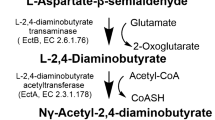Summary
The aim of this study was to elucidate the protective effect of the new compatible solutes, ectoine and hydroxyectoine, on two sensitive enzymes (lactic dehydrogenase, phosphofructokinase). The solutes tested also included (for reasons of comparison) other compatible solutes such as glycine betaine and a number of disaccharides (sucrose, trehalose, maltose). All compatible solutes under investigation displayed remarkable stabilizing capabilities. However, the degree of protection depended on both the type of solute chosen and the enzyme used as a test system. The most prominent protectants were trehalose, ectoine and hydroxyectoine, which are very often found in nature (singly or in combinationn) as part of the compatible solute “cocktail” of moderately halophilic eubacteria.
Similar content being viewed by others

References
Arakawa T, Timasheff SN (1985) The stabilization of proteins by osmolytes. Biochemistry 47:411–414
Back JF, Oakenfull D, Smith MB (1979) Increased thermal stability of proteins in the presence of sugars and polyols. Biochemistry 18:5191–5196
Bock PE, Frieden C (1974) pH-Induced cold lability of rabbit skeletal muscle phosphofructokinase. Biochemistry 13:4191–4196
Brown AD (1976) Microbial water stress. Bacteriol Rev 40:803–846
Carpenter JT, Crowe LM, Crowe JM (1987) Stabilization of phosphofructokinase with sugars during freeze-drying: characterization of enhanced protection in the presence of divalent cations. Biochim Biophys Acta 923:109–115
Carpenter JF, Crowe JH (1988) The mechanism of cryoprotection of proteins by solutes. Cryobiology 15:244–255
Carpenter JF, Crowe JH (1989) An infrared spectroscopic study of the interactions of carbohydrates with dried proteins. Biochemistry 28:3916–3922
Chilson OP, Costello LA, Kaplan NO (1965) Effects of freezing on enzymes. Fed Proc 24:55–65
Crowe JH, Carpenter JF, Crowe LM, Anchordoguy TJ (1990) Are freezing and dehydration similar stress vectors? A comparision of modes of interaction of stabilizing solutes with biomolecules. Cryobiology 27:219–231
Galinski EA, Lippert K (1991) Novel compatible solutes and their potential application as stabilizers in enzyme technology. In: Rodriguez-Valera F (ed) General and Applied Aspects of Halophilic Microorganisms. Plenum Press, New York, pp 351–358
Galinski EA, Pfeiffer HP, Trüper HG (1985) 1,4,5,6-Tetrahydro-2-methyl-pyrimidincarboxylic acid: a novel cyclic amino acid from halophilic phototrophic bacteria of the genus Ectothiorhodospira halochloris. Eur J Biochem 149:135–139
Hanofusa N (1969) Denaturation of enzyme protein by freeze-thawing and freeze-drying. In: Nei T (ed) Freezing and drying of microorganisms. University Park Press, Baltimore, pp 117–129
Jolivet Y, Larher F, Hamelin J (1982) Osmoregulation in halophilic higher plants: the protective effect of glycine betaine against the heat destabilization in membranes. Plant Sci Lett 25:193–201
Paleg LG, Douglas TJ, Daal A van, Keech DB (1981) Betaine and other organic solutes protect enzymes against heat inactivation. Aust J Plant Physiol 8:107–110
Severin J, Wohlfarth A, Galinski EA (1992) The predominant role of recently discovered tetrahydropyrimidines for the osmoregulation of halophilic eubacteria (in press)
Shikama K, Yamazaki I (1961) Denaturation of catalase by freezing and thawing. Nature 190:83–84
Trüper HG, Galinski EA (1986) Concentrated brines as habitats for microorganisms. Experientia 42:1182–1187
Wohlfarth A, Severin J, Galinski EA (1988) Screening for compatible solutes of halophilic eubacteria. In: Costa MS da, Duarte JC, Williams RAD (ed) FEMS symposium, Troia, Portugal: The microbiology of extreme environments and its potential for biotechnology. Elsevier, London, p 421
Wohlfarth A, Severin J, Galinski EA (1990) The spectrum of compatible solutes in heterotrophic halophilic eubacteria of the family Halomonadaceae. J Gen Microbiol 136:705–712
Author information
Authors and Affiliations
Additional information
Offprint request to: E. A. Galinski
Rights and permissions
About this article
Cite this article
Lippert, K., Galinski, E.A. Enzyme stabilization be ectoine-type compatible solutes: protection against heating, freezing and drying. Appl Microbiol Biotechnol 37, 61–65 (1992). https://doi.org/10.1007/BF00174204
Received:
Accepted:
Issue Date:
DOI: https://doi.org/10.1007/BF00174204



